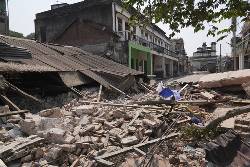BANGKOK (AP) — The Southeast Asian nation of Myanmar has been plagued by wars and natural disasters since it became independent from Britain in 1948, when it was still called Burma.
Relief efforts from Friday’s devastating 7.7 magnitude earthquake will be especially complicated with the country in embroiled in civil war, which began after the army seized power from the elected government of Aung San Suu Kyi in February 2021.
The main resistance movement against military rule has issued a statement saying it is unilaterally initiating a two-week ceasefire beginning Sunday in areas of the country affected by the quake.
There was no immediate reaction from the military government, which even before the earthquake — in addition to employing massive repression and state violence — heavily restricted much-needed aid to the more than 3 million people displaced by war.
The army’s ability to facilitate or block food and other assistance has been described as a way of weaponizing aid. Critics of the military government have called repeatedly for outside assistance to be delivered directly to areas under control of the resistance.
Who are the protagonists in Myanmar’s armed conflict?
The military, which has directly or indirectly ruled Myanmar most of the time since independence, seized power from Suu Kyi’s government as it was about to begin a second five-year term. She and leaders of her National League for Democracy party were jailed, and security forces put down pro-democracy demonstrations with deadly force, leading to the growth of armed resistance, and the army in turn escalating its violence.
Despite a massive disadvantage in weaponry and manpower, pro-democracy fighters allied with ethnic minority groups seeking greater autonomy have successfully battled back, and analysts believe they control a much greater share of territory.
The resistance is coordinated by the self-styled National Unity Government, whose claim to legitimacy is that it was formed by elected lawmakers. The NUG, which operates underground, has an armed wing called the People's Defense Force.
The PDF is largely a conglomeration of locally formed defense groups, poorly armed but usually with the advantage of fighting on home ground. Their ethnic allies are much more experienced and have even managed in some cases to manufacture their own weapons.
What exactly has the resistance proposed?
The National Unity Government said in an announcement Saturday the People’s Defense Force will implement a two-week pause in offensive military operations starting Sunday in earthquake-affected areas, while retaining the right to self-defense.
It said it would collaborate with the U.N. and international NGOs "to ensure security, transportation, and the establishment of temporary rescue and medical camps,” in the areas it controls. It also offered to provide healthcare professionals loyal to its resistance movement to work with international humanitarian organizations to deliver emergency rescue and medical services in areas under the military’s control if provided with safety guarantees.
What is the significance of resistance's announcement?
The PDF fighters rarely mount large-scale offensives, sticking mainly to defense and ambush-style attacks, so its ceasefire would be largely symbolic. By taking the moral high ground, it gives its supporters a stronger argument to push for the unrestricted distribution of aid.
Although the military government has made the rare gesture of soliciting foreign emergency aid, its critics are skeptical it will deploy it fairly and effectively.
The military’s record is discouraging. For instance, it initially refused to allow in foreign rescue teams or many emergency supplies after Cyclone Nargis in 2008, which resulted in well over 100,000 deaths, and tens of thousands more left unaccounted for. Even after it agree to accept foreign help, it was with severe restrictions.
When Cyclone Mocha ripped into the coast in May 2023, the military's relief efforts were again tardy, and as in 2008, private relief missions were discouraged, as was reporting. Property damage was heavy and while 145 deaths were officially acknowledged, independent accounts put the total over 400.
There are examples in other countries when the effort to rebuild after natural disasters have played a part in helping to restore peace to areas torn by conflict, most notably in Indonesia’s Aceh province after it was devastated by the 2004 Indian Ocean tsunami.
...


 Copyright © 1996 - 2025 CoreComm Internet Services, Inc. All Rights Reserved. | View our
Copyright © 1996 - 2025 CoreComm Internet Services, Inc. All Rights Reserved. | View our